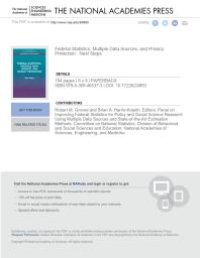
Ebook: Federal Statistics, Multiple Data Sources, and Privacy Protection: Next Steps
Author: and Medicine Engineering National Academies of Sciences, Division of Behavioral and Social Sciences and Education, Committee on National Statistics, Panel on Improving Federal Statistics for Policy and Social Science Research Using Multiple Data Sources and State-of-the-Art Estimation Methods, Brian A. Harris-Kojetin, Robert M. Groves
- Tags: COM030000, SCI043000, SOC027000
- Year: 2018
- Publisher: National Academies Press
- City: Washington, D.C., United States
- Edition: 1
- Language: English
- epub
The environment for obtaining information and providing statistical data for policy makers and the public has changed significantly in the past decade, raising questions about the fundamental survey paradigm that underlies federal statistics. New data sources provide opportunities to develop a new paradigm that can improve timeliness, geographic or subpopulation detail, and statistical efficiency. It also has the potential to reduce the costs of producing federal statistics. The panel's first report described federal statistical agencies' current paradigm, which relies heavily on sample surveys for producing national statistics, and challenges agencies are facing; the legal frameworks and mechanisms for protecting the privacy and confidentiality of statistical data and for providing researchers access to data, and challenges to those frameworks and mechanisms; and statistical agencies access to alternative sources of data. The panel recommended a new approach for federal statistical programs that would combine diverse data sources from government and private sector sources and the creation of a new entity that would provide the foundational elements needed for this new approach, including legal authority to access data and protect privacy. This second of the panel's two reports builds on the analysis, conclusions, and recommendations in the first one. This report assesses alternative methods for implementing a new approach that would combine diverse data sources from government and private sector sources, including describing statistical models for combining data from multiple sources; examining statistical and computer science approaches that foster privacy protections; evaluating frameworks for assessing the quality and utility of alternative data sources; and various models for implementing the recommended new entity. Together, the two reports offer ideas and recommendations to help federal statistical agencies examine and evaluate data from alternative sources and then combine them as appropriate to provide the country with more timely, actionable, and useful information for policy makers, businesses, and individuals.
Download the book Federal Statistics, Multiple Data Sources, and Privacy Protection: Next Steps for free or read online
Continue reading on any device:

Last viewed books
Related books
{related-news}
Comments (0)